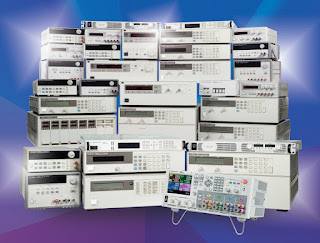Once you know your DUT’s power requirements, you can begin to peruse the specs in various power supply data sheets to find one that meets your needs. Most likely, you will be considering specs such as:
- DC output ratings
- These show the maximum voltage, current, and power available from the power supply. Make sure your DC input requirements are within these values.
- Output noise
- This specification describes the deviations in the DC output voltage, typically expressed as peak-to-peak volts and rms volts. If your DUT is sensitive to noise, be sure to choose a low noise power supply.
- Load regulation (also called load effect)
- This spec shows how much the steady-state output voltage can change when the load current changes. If you want the input voltage to your DUT to vary very little when your DUT current changes, choose a power supply with low load regulation.
- Load transient recovery time
- This is the time for the output voltage to recover to within a settling band around the steady-state value when the load current changes. If your DUT is sensitive to large short-term input voltage changes, choose a power supply with a short load transient recovery time.
- Line regulation (also called line effect, source regulation, or source effect)
- This spec shows how much the steady-state output voltage can change when the power supply’s AC input line voltage changes. If you want the input voltage to your DUT to vary very little when your AC line voltage changes, choose a power supply with low line regulation.
- Programming accuracy
- This spec shows how much the steady-state output voltage can vary from its programmed (set) value. If you want the input voltage to your DUT to be very precisely controlled, choose a power supply with a low programming accuracy. (Most “programming accuracy” specs are really describing the maximum possible “programming error”, so you want this number to be low.)
- Measurement accuracy
- This spec shows how much the steady-state measurements (voltage or current) can vary from the actual output value. If you are counting on measuring your DUT’s input voltage or current with high accuracy, choose a power supply with low measurement accuracy. (Most “measurement accuracy” specs are really describing the maximum possible “measurement error”, so you want this number to be low.)
http://www.designworld-digital.com/designworld/201303#pg71
The same article can be accessed here:
http://www.powersupplytips.com/how-to-read-your-dc-power-supplys-data-sheet
Finally, here is a link to Kevin’s application note – the article was based on this app note:
http://cp.literature.agilent.com/litweb/pdf/5991-2293EN.pdf
Kevin’s app note uses examples from the data sheets for a Sorenson power supply and an Agilent power supply. You will notice that the magazine articles refer to these as Power Supply A and Power Supply B.

No comments:
Post a Comment
Note: Only a member of this blog may post a comment.